
In the Low Countries, stadtholder was an office of steward, designated a medieval official and then a national leader. The stadtholder was the replacement of the duke or earl of a province during the Burgundian and Habsburg period.

The Patriottentijd was a period of political instability in the Dutch Republic between approximately 1780 and 1787. It takes its name from the radical political faction known as the Patriotten who opposed the rule of the stadtholder, William V, Prince of Orange, and his supporters who were known as Orangists.
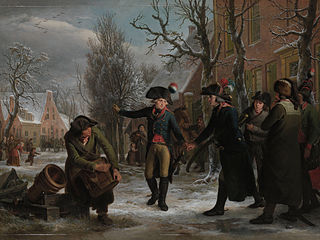
The Batavian Revolution was a time of political, social and cultural turmoil at the end of the 18th century that marked the end of the Dutch Republic and saw the proclamation of the Batavian Republic. The period of Dutch history that followed the revolution is referred to as the "Batavian-French era" (1795–1813) even though the time spanned was only 20 years, of which three were under French occupation.

The Admiralty of Amsterdam was the largest of the five Dutch admiralties at the time of the Dutch Republic. The administration of the various admiralties was strongly influenced by provincial interests. The territory for which Amsterdam was responsible was limited to the city itself, the Gooi region, the islands of Texel, Vlieland and Terschelling, the province of Utrecht and the Gelderland quarters of Arnhem and of the Graafschap (county) of Zutphen. Amsterdam had developed into the most important of all the admiralties and often compensated for the other admiralties' deficiencies. When the "Committee for Naval Affairs" replaced the Admiralty Colleges on 27 February 1795 during the reforms by the Batavian Republic, the lower civil servants were kept on, but the officers were dismissed.
A referendum on the constitution of the Batavian Republic was held on August 8, 1797. The draft constitution was rejected, eventually culminating in a coup d'état.

Pieter Philips Jurriaan Quint Ondaatje was a Dutch patriot and politician. He is called the champion of Dutch democracy.
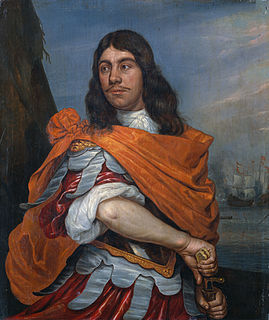
In the history of the Dutch Republic, Orangism or prinsgezindheid was a political force opposing the Staatsgezinde (pro-Republic) party. Orangists supported the princes of Orange as Stadtholders and military commanders of the Republic, as a check on the power of the regenten. The Orangist party drew its adherents largely from traditionalists – mostly farmers, soldiers, noblemen and orthodox Catholic and Protestant preachers, though its support fluctuated heavily over the course of the Republic's history and there were never clear-cut socioeconomic divisions.
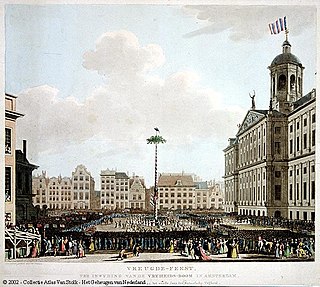
The Batavian Revolution in Amsterdam refers to the transfer of power in the city of Amsterdam on 18 January 1795 to a Revolutionary Committee of the new Batavian Republic. The same day the stadtholder of the Dutch Republic, William V, Prince of Orange fled the country. Amsterdam was the first city that declared itself in the Batavian Revolution that brought about the Batavian Republic.
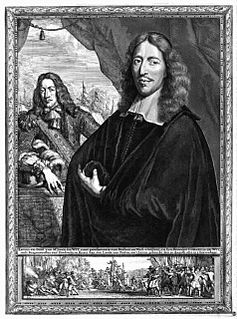
The Loevestein faction or the Loevesteiners were a Dutch States Party in the second half of the 17th century in the County of Holland, the dominant province of the Dutch Republic. It claimed to be the party of "true freedom" against the stadtholderate of the House of Orange-Nassau, and sought to establish a purely republican form of government in the Northern Netherlands.

The Prussian invasion of Holland was a Prussian military campaign in September–October 1787 to restore the Orange stadtholderate in the Dutch Republic against the rise of the democratic Patriot movement.
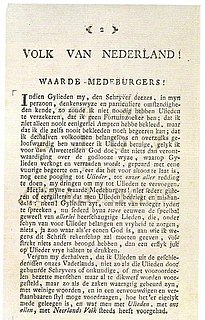
Aan het Volk van Nederland was a pamphlet distributed by window-covered carriages across all major cities of the Dutch Republic in the night of 25 to 26 September 1781. It claimed the entire political system, dominated by the Orange hereditary stadtholderate, was corrupt and had to be overthrown in favour of a democratic republic. The pamphlet became the creed of the Patriots.

The Act of Guarantee of the hereditary stadtholderate was a document from 1788, in which the seven provinces of the States General and the representative of Drenthe declared, amongst other things, that the admiralty and captain-generalship were hereditary, and together with the hereditary stadtholderate would henceforth be an integrated part of the constitution of the Dutch Republic. Moreover, members of the House of Orange-Nassau would have the exclusive privilege to hold the office. The Act was in force until the Batavian Republic was established in 1795.
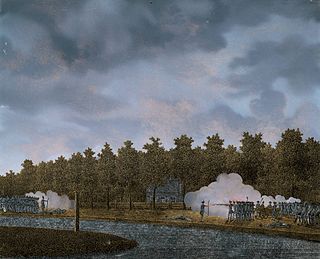
The Battle of Jutphaas, also known as the Battle of the Vaart or the Battle of Vreeswijk, occurred on 9 May 1787 on the banks of the Vaartsche Rijn canal near Jutphaas and Vreeswijk between Orangists and Patriots.

Adriaan van Zeebergh was a Dutch politician during the Patriottentijd.

Hendrik Daniëlszoon Hooft, Ambachtsheer of Urk and Emmeloord was a Dutch politician during the Patriottentijd.

Pieter 't Hoen was a Dutch journalist, poet, and politician who played an important role during the Patriottentijd as the editor of De Post van den Neder-Rhijn.

Joachim Rendorp, Vrijheer of Marquette was a Dutch politician of the Patriottentijd in the Dutch Republic.

Willem Gerrit Dedel SalomonszoonAmbachtsheer of Sloten and Sloterdijk was a Dutch politician during the Patriottentijd in the Dutch Republic.

Jean Antoine d'Averhoult, baptized as Jan Anthony d'Averhoult was a Dutch military officer and politician of French Huguenot extraction, who played a leading role in both the Patriottentijd and the French Revolution.

The Nieuwe Vaart or Nieuwevaart is a 17th-century canal in Amsterdam that runs from the center to Amsterdam-Oost.



















